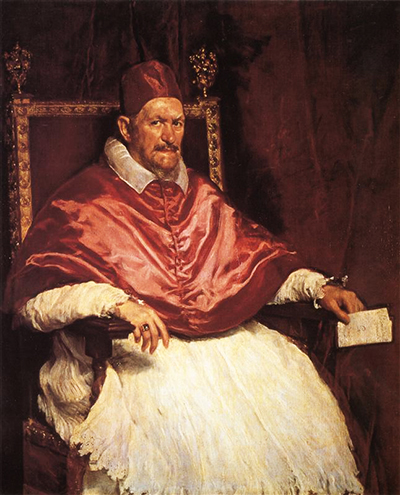Velazquez's paintings became popular over time and in December 1622, he was appointed as one of the royal court artists. Philip IV was impressed with Velazquez's works and the very next year, the king sat for a portrait.
The portrait was actually completed in one day and the king was immensely pleased with it, so much so that he wanted all other portraits of himself removed from circulation and only Velazquez would henceforth paint him. This sealed Velazquez's reputation as a great painter, but he was yet to do his most famous work - Las Meninas.
On his second trip to Italy in 1650, Velazquez was commissioned to paint the portrait of Pope Innocent X. He was happy to take up the challenge and the result is considered to be one of the finest portraits ever painted. The painting shows the Pope sitting in the papal chair dressed in red and white, and the result is dramatic.
These two colours are predominant in the portrait. The artist has managed to create folds by the use of different shades of a single colour and the use of red in the robes, chair, carpet, and curtains brings forth the brilliance of the colour scheme of this painting.
The intelligence and shrewdness shines through from the man in the portrait. The parchment in the Pope's hand has Velazquez's signature. The portrait is considered a highly realistic depiction of the man and indeed, the Pope himself at first was taken aback and exclaimed that it was too true to form.
The depiction is a sharp contrast to the softer and edited portrait visualisations prevalent at the time. The painting is created in the Baroque and Realism form, with a touch of Impressionism. The portrait later inspired Francis Bacon's series of 'Screaming Popes' portraits.
Though the Pope was wary at first about this undertaking, but was very pleased with the result and presented Velazquez with a gold chain. The painting was aptly named Retrato de Inocencio X or Portrait of Pope Innocent X.
The portrait was displayed privately for a couple of centuries and remained a hidden masterpiece during this time. It was later handed over to the Doria-Pamphilj Gallery in Rome, where it was housed in one of Rome's largest private collections. A special chamber was built for displaying this painting separately in 1927 by Filippo Andrea Doria Pamphilj V. The portrait was made available to the general public only in the last three decades.
Diego Velazquez was a Spanish artist who painted in the 17th century. His grandparents were immigrants to Spain from Portugal, and were possibly Jewish traders.
Velazquez received a good education and learned some art from Francisco de Herrera, a painter. When he was twelve, Velazquez was apprenticed to another Spanish painter, Francisco Pacheco. Thus, he received art education from a very young age and grew up with an understanding of the theories and interpretation of art, as well as developing his own talent.




